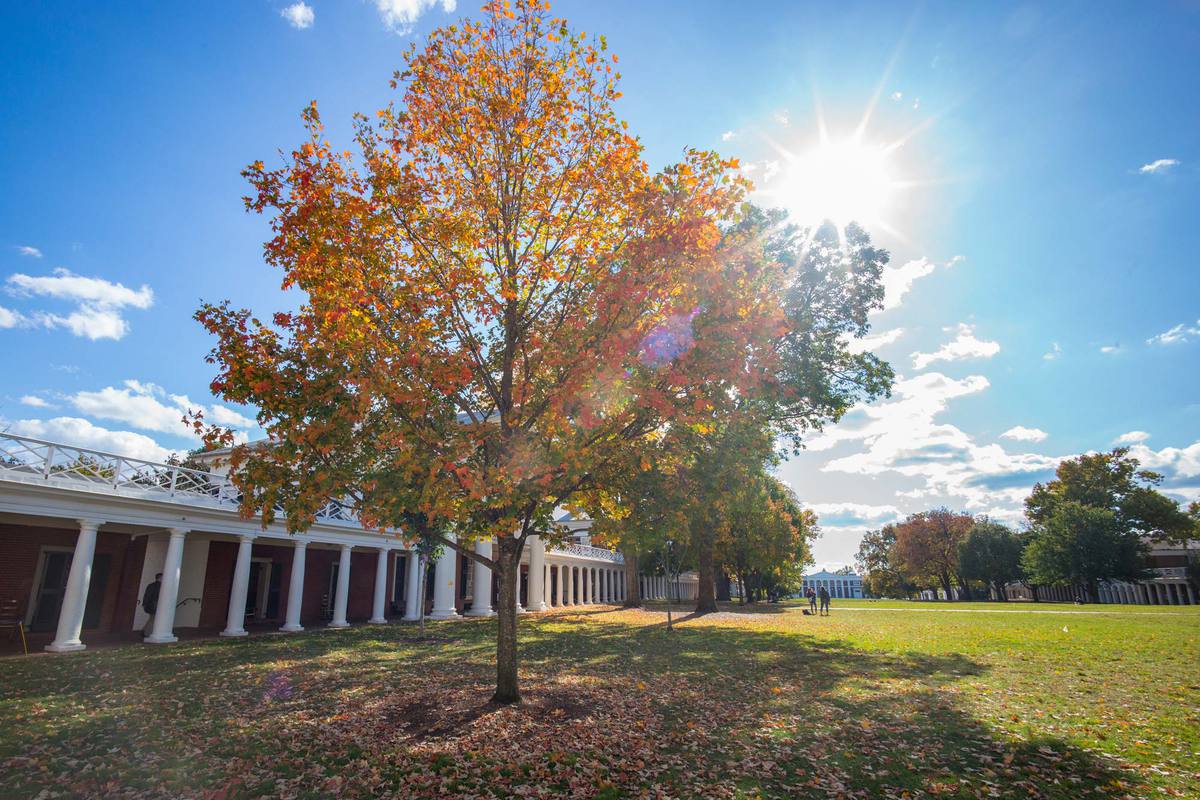The University of Virginia and William & Mary today announced plans to work together on sustainability and climate change initiatives, including a shared goal for each institution to be carbon neutral by 2030.
The innovative partnership is part of UVA’s 2020-30 Sustainability Plan, which will be presented to the University’s Board of Visitors this week. If approved, it would set goals for UVA to be carbon neutral by 2030 and fossil-fuel-free by 2050.
UVA and W&M plan to regularly share information and resources on their respective strategic climate action plans and implementation. The schools will collaborate on outreach and engagement opportunities internally and with their surrounding localities, as well as support other higher education institutions.
The plan under consideration by the Board of Visitors builds on UVA’s significant progress in meeting or exceeding several previous sustainability and greenhouse gas emissions goals years ahead of schedule.
“I want to thank the teams across UVA who have helped us reach our sustainability goals ahead of schedule,” UVA President Jim Ryan said. “I look forward to discussing new goals with the Board of Visitors later this week.
“I also want to thank William & Mary for their partnership, and for making it clear that the only way we can address issues like climate change is by working together.”
James B. Murray, rector of the Board of Visitors, applauded the opportunity to set more aggressive targets and to collaborate with William & Mary and others.
“Sustainability is a strategic priority for the University of Virginia, but it’s an important issue for everyone,” Murray said. “The Board of Visitors is eager to join the discussion around how UVA can both play a leadership role and be a good partner.”
The announcements are part of broader sustainability efforts across the commonwealth. Virginia Gov. Ralph Northam signed an executive order earlier this fall setting a goal for Virginia to produce 100% of its energy from carbon-free sources by 2050.
In 2011, the Board of Visitors endorsed a goal for the University to reduce greenhouse gas emissions 25% below 2009 levels by 2025. That goal will be reached this year, six years ahead of schedule.
A subset of the proposed 2020-30 plan’s goals, under the title “30 by 30,” includes reducing water use and reactive nitrogen emissions by 30%, reducing UVA’s waste footprint to 30% and increasing its sustainable food purchases to 30%, all relative to the University’s 2010 levels.
“UVA will seek to catalyze change to advance these new, ambitious sustainability goals in ways that create replicable and collaborative models to build bridges with our community and beyond,” Andrea Trimble, director of UVA’s Office of Sustainability, said. “The potential to work with the surrounding region as well as other institutions of higher education, including William & Mary, offers a leadership and partnership opportunity that will scale up equitable climate change solutions on Grounds and beyond.
“Examples of the possible challenges we’ll be evaluating together could be moving away from fossil fuels, weighing new construction and population growth, collecting data and identifying strategies to reduce emissions from commuting, business travel and study abroad. Both parties could benefit from swifter climate action, pooled resources and knowledge, a more regional focus on climate action, and the potential to replicate and amplify the impacts beyond the two schools.”
Apart from its connection with William & Mary, the University’s plan calls for partnering with the surrounding community to accelerate initiatives to advance sustainable, equitable and healthy places for all. The University is already working with the City of Charlottesville and Albemarle County on developing greenhouse gas reduction targets and climate action plans.
“As a top-ranked public university moving into its third century, it is crucial that UVA continue to demonstrate bold leadership in addressing sustainability challenges – particularly climate change – across the interconnected areas of teaching, research, operations and community engagement,” Phoebe Crisman, professor of architecture and co-chair of the Committee on Sustainability, said. “Our collaborative network of students, faculty, staff and alumni provides a strong foundation for UVA to lead transformational change, both locally and globally.”
The University’s plan includes a wide range of strategies that will increase efficiency and reduce UVA’s operational impact on the environment.
“Key initiatives to meet the carbon neutrality and fossil-fuel free goals include addressing heat plant fuel infrastructure, heat recovery technology, aggressive energy performance standards, net-zero for capital construction, increasing renewable energy and advancing a sustainable transportation plan,” said Cheryl Gomez, director of operations for Facilities Management and co-chair of the University’s Committee on Sustainability.
UVA’s latest goals include implementing a climate action plan, expanding plant-based meal offerings, switching to sustainably raised meats, reducing food waste and increasing access to community-based producers and sourcing local foods.
In reducing its waste footprint, the University will expand the availability of interior and exterior waste and recycling bins, expand zero-waste events and composting, commit to eliminating single-use plastics and provide additional training and outreach. It is also pledging to increase the efficiency of the chilled water plant operations and upgrading fixtures Grounds-wide.
The University is also looking to change everyday behaviors through sustainability-focused research and curriculum programs, which help people incorporate environmental, economic and equity considerations in decision-making. Each school and unit will have accountability for achieving sustainability goals by developing action plans aligned with the University’s plan.
“The UVA 2020-30 Sustainability Plan is part of larger strategic framework, connected to the UVA 2030 strategic plan, school and unit plans, and a series of action plans that will describe UVA’s approach to meeting each goal,” Gomez said.
The Board of Visitors is scheduled to consider the new sustainability proposal on Friday.
Media Contact
Article Information
November 26, 2019
/content/uva-wm-partner-10-year-goal-achieving-carbon-neutrality

